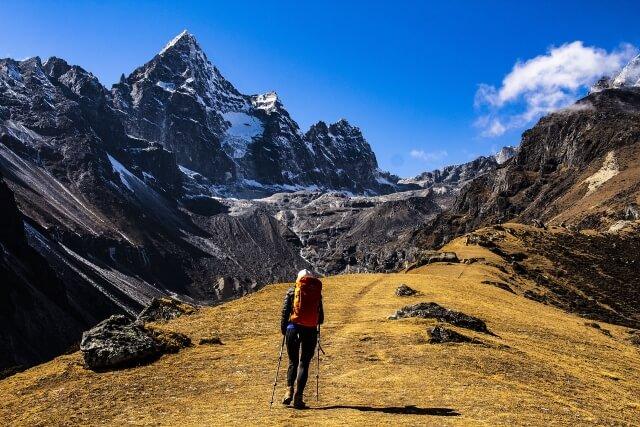Hey there fellow adventure seekers! If you’re like me, you can’t resist the allure of the great outdoors and the thrill of conquering mountain trails. There’s something truly magical about hiking through rugged landscapes, feeling the crisp mountain air against your skin, and soaking in the breathtaking vistas from the summit.
But amidst all this excitement, it’s crucial not to overlook a fundamental aspect of any mountain expedition: safety. Whether you’re a seasoned hiker or a newbie planning your first mountain trek, understanding the essential safety tips can make all the difference between an unforgettable adventure and a potential disaster.
In this comprehensive guide, we’ll be exploring the “10 Essential Safety Tips for Hiking in the Mountains” to ensure you have a safe and enjoyable journey. From preparing your gear to navigating challenging terrains, we’ll cover everything you need to know to make your mountain hiking experience not only thrilling but also secure.

So, if you’re ready to arm yourself with the knowledge that can safeguard you and your fellow adventurers on the trails, let’s dive right in and get you set for an epic mountain escapade!
Are you excited? Let’s hit the trails together and uncover the secrets to a safe and rewarding hiking expedition!
Importance of safety in mountain hiking
Safety in mountain hiking is the cornerstone of every thrilling adventure. Just like a sturdy tent needs a solid foundation, embarking on a hike requires proper safety measures. Picture the excitement of a roller coaster ride; you want the thrills without the worries. That’s why knowing essential safety tips is crucial. Unpredictable weather and challenging trails can pose risks, but being prepared and informed minimizes them.
Let’s prioritize safety and make our mountain hike unforgettable.
1. Plan Ahead
Research hiking trails and conditions
Planning ahead is the key to a successful mountain hike. Before you set off on your adventure, take the time to research hiking trails and current conditions. It’s like plotting the course before sailing the seas. Knowing the terrain, weather forecasts, and any potential hazards will equip you for the journey ahead.
Think of it as studying the map before embarking on a grand expedition. With proper research, you can choose trails that match your skill level and avoid unexpected challenges.

Check weather forecasts
As you gear up for your mountain hike, don’t forget to check the weather forecasts. It’s like consulting a crystal ball before stepping out on an adventure. Knowing what Mother Nature has in store can make all the difference in your journey. Imagine it as packing an umbrella when rain is predicted; being prepared for weather changes is essential. Whether it’s sunshine or storms, having this information helps you adjust your plans and pack accordingly. So, let’s be weather-wise and ensure a smooth and safe mountain hiking experience.
2. Physical Preparedness
Maintain good physical fitness
Physical preparedness is paramount for a successful mountain hike. It’s like fueling up a car before a long road trip. Maintaining good physical fitness sets the foundation for an enjoyable and safe adventure. Think of it as having the stamina to embrace the challenges ahead.
Regular exercise and conditioning not only enhance your hiking experience but also reduce the risk of injuries. Just like a well-trained athlete excels in their sport, being physically fit allows you to conquer those trails with confidence. So, lace up your shoes, stay active, and get your body ready for the incredible journey that lies ahead!

Pack appropriate clothing and footwear
Physical preparedness extends beyond just fitness; it also involves packing the right clothing and footwear for your mountain hike. Think of it as dressing appropriately for a special occasion. The mountains have their dress code, and we must follow it to stay comfortable and safe. Wearing moisture-wicking and layered clothing helps regulate body temperature, while sturdy and well-fitted footwear provides stability and support.
Clothing:
- Moisture-wicking base layers: These are essential to keep sweat away from your skin, helping you stay dry and comfortable during the hike.
- Breathable and lightweight shirts: Opt for shirts made from materials like nylon or polyester that allow airflow and prevent overheating.
- Quick-drying pants or convertible hiking pants: These pants are versatile and ideal for various weather conditions. They dry quickly if you encounter rain or cross-water streams.
- Insulating layers: Depending on the weather, pack a fleece or insulated jacket to stay warm during colder temperatures or chilly evenings.
- Waterproof and windproof jacket: A durable and waterproof outer layer is crucial to protect you from rain, wind, and sudden weather changes.
Footwear:
- Hiking boots: Invest in sturdy, ankle-supporting hiking boots with good traction to provide stability on rocky and uneven terrain.
- Trail running shoes: For less challenging hikes or well-maintained trails, lightweight trail running shoes offer comfort and flexibility.
- Gaiters: These protective coverings attach to your boots and prevent debris like rocks, mud, and snow from entering, keeping your feet clean and dry.
- Extra pairs of socks: Always bring moisture-wicking, cushioned hiking socks to reduce the risk of blisters and keep your feet comfortable during long hikes.
- Sandals or camp shoes: Carrying lightweight sandals to wear around the campsite allows your feet to rest and breathe after a day of hiking.
By choosing the right clothing and footwear, you’ll be well-prepared to face the varying conditions and terrains that come your way during a mountain hike. Remember, comfort and safety should be your top priorities when selecting your gear.
Carry essential hiking gear and supplies
Carrying essential hiking gear and supplies is like having a trusted companion by your side during your mountain adventure.

These items are the backbone of your journey, providing the tools you need to tackle challenges and stay safe. Let’s take a closer look at some of the must-have gear and supplies to pack in your backpack:
- Navigation tools: In the vast wilderness, knowing where you are and where you’re heading is crucial. A topographic map, a compass, or a GPS device can be a lifesaver, guiding you along the right path and preventing you from getting lost.
- Hydration system: Dehydration can quickly sap your energy and put you at risk. Carry a reliable water reservoir, water bottles, or a hydration bladder to ensure you have enough water to drink throughout the hike. Staying hydrated is essential, especially in hot and high-altitude environments.
- Snacks and meals: Fuel your body with energy-boosting snacks and nourishing meals. Pack a mix of trail mix, energy bars, and fresh fruits for quick bites on the go. For longer hikes, consider lightweight, dehydrated meals that are easy to prepare with hot water.
- First aid kit: Accidents happen, and being prepared to handle minor injuries is essential. Your first aid kit should include adhesive bandages, antiseptic wipes, pain relievers, and any personal medications you may need.
- Emergency shelter: Nature can be unpredictable, and weather conditions can change rapidly. Carry a lightweight emergency shelter, such as a space blanket or bivy sack, to provide protection in case you need to stay outdoors longer than expected.
- Multi-tool or knife: A versatile tool, like a multi-tool or a sturdy knife, is a handy addition to your gear. It can assist with various tasks, from cutting ropes to repairing equipment.
- Sun protection: Shield yourself from the sun’s harmful rays by wearing sunglasses, a wide-brimmed hat, and applying sunscreen with a high SPF rating. Sun protection is crucial, especially at higher altitudes where UV rays are stronger.
- Headlamp or flashlight: Prepare for low-light conditions by carrying a reliable headlamp or flashlight. It’s essential for navigating in the dark or finding items in your backpack during the night.
- Fire-starting materials: In emergencies or survival situations, having the means to start a fire can provide warmth, cook food, and signal for help. Waterproof matches, a lighter, or a fire starter kit are all valuable items to pack.
- Communication device: A fully charged cellphone or a satellite communicator can be a lifeline if you encounter an emergency or need to contact others. Keep in mind that cell reception may be unreliable in remote mountain areas, so having a satellite communicator can be a more reliable option.
By carefully packing these essential hiking gear and supplies, you’ll be well-prepared to face the challenges of the wilderness and ensure a safe and memorable mountain hiking experience. Remember, these items are not just tools but symbols of your readiness and respect for nature’s unpredictability.
3. Hike with a Buddy
Benefits of hiking with a companion
Hiking with a buddy adds a layer of security and enjoyment to your mountain adventure. Benefits include safety in numbers, shared experiences, motivation, problem-solving, and enhanced preparedness. Having a companion also means enjoyable conversations and capturing memories together.
A hiking buddy becomes your support team, providing encouragement and assistance when needed. So, before you hit the trails, consider bringing a friend along to make your journey unforgettable and safer.
Maintain communication and stay together
Maintaining communication and staying together is the golden rule for a successful mountain hike with your buddy. It’s like keeping a lifeline intact throughout your journey.
Communication ensures you’re always aware of each other’s whereabouts and well-being, reducing the risk of getting separated. Whether it’s using walkie-talkies, cell phones, or a designated meeting point, staying connected is vital. It’s like having an unbreakable bond that ensures you both experience the wonders of the trail together.

Assist each other in case of emergencies
Assisting each other in emergencies is the ultimate pact between hiking buddies. It’s like having each other’s back in times of need. When unforeseen situations arise, you become each other’s support and strength. From providing first aid to seeking help or making crucial decisions together, your bond becomes a lifeline.
It’s like forging a partnership that can overcome any challenge nature throws your way. So, let’s make a promise to be there for our hiking companion, no matter what. With this mutual support, we can confidently face any obstacle on our mountain journey. Be each other’s, guardian angels.
4. Weather Awareness
Be prepared for sudden changes in the weather
Weather awareness is the key to conquering the mountains safely. It’s like having a sixth sense that keeps you one step ahead of nature’s whims. Mountains are notorious for unpredictable weather changes, and being prepared is non-negotiable.
Imagine it as checking the weather forecast before stepping out the door but with the added challenge of mountainous terrain. Always carry extra layers for warmth, a waterproof jacket, and gear to protect against rain or snow. It’s like having weather-resistant armor that ensures you’re ready for anything. Embrace weather awareness and stay vigilant for sudden changes.

Seek shelter and avoid exposed areas during storms
In the mountains, seeking shelter and avoiding exposed areas during storms is essential for safety. Storms can strike unexpectedly, bringing rain, lightning, and strong winds. Find refuge in natural shelters or safe spots to protect yourself. Avoid exposed areas like ridge lines to minimize risks. Prioritize safety to weather storms and continue the hike confidently.
5. Safety in Mountainous Terrain
Be cautious on steep or slippery slopes
Safety in mountainous terrain is paramount, especially when navigating steep or slippery slopes. Mountain trails can present rugged, uneven surfaces that demand caution and focus. Imagine it as walking on a tightrope; every step requires attention.
Slow down your pace, use trekking poles for stability, and wear sturdy, well-gripping footwear. It’s like having surefooted anchors that keep you steady. Being cautious on these terrains reduces the risk of slips, falls, and injuries.
Use proper techniques for ascents and descents
Using proper techniques for ascents and descents is essential for a successful mountain hike. Ascending and descending require different approaches. Imagine it as learning elegant moves to navigate the rugged terrain.
When climbing uphill, maintain a steady pace, take regular breaks, and use your legs’ strength. It’s like taking measured steps to conquer each incline.
When descending, lean slightly backward, use trekking poles for balance, and choose stable footholds. It’s like gracefully descending a staircase.
Following these techniques reduces strain on your body and minimizes the risk of injuries. So, let’s dance with the mountains and master these techniques for a seamless and delightful hike.

Avoid dangerous areas like cliffs or unstable rock formations
Certain areas may pose significant risks, and it’s essential to exercise caution and good judgment. Keep a safe distance from cliffs and unstable rocks to avoid accidents or rockfalls. It’s like staying away from potential hazards. Prioritize your safety and that of your hiking buddy by being mindful of your surroundings. So, let’s be smart and avoid these danger zones, ensuring a secure and worry-free mountain adventure.
6. Navigation and Trail Markings
Understand trail maps and markings
Understanding trail maps and markings is like having a compass that guides you through the wilderness. Before embarking on any mountain hike, take the time to study the trail maps and become familiar with the trail markers. These tools are your allies in ensuring you stay on the right path and reach your destination safely.
Pay close attention to trail signs, cairns, and blazes along the way. They are like little breadcrumbs left by previous hikers to lead you in the right direction. These markers are especially vital in areas where trails might be less defined or covered by snow or foliage.
Moreover, knowing how to read the landscape can be invaluable for navigation. Observe prominent landmarks, such as distinct peaks or rock formations, to orient yourself on the map and track your progress.
If you’re unsure about a trail’s direction or have any doubts, don’t hesitate to ask fellow hikers or seek advice from park rangers at visitor centers. We’re here to help you have a safe and enjoyable experience in our magnificent mountains.
By mastering the art of navigation and understanding trail markings, you can confidently explore the wonders of the mountains and make the most of your hiking journey. Remember, the mountains offer a world of breathtaking beauty, and with the right knowledge and preparation, you’ll embark on unforgettable adventures.

Carry a compass and learn basic navigation skills
As a park ranger and experienced mountaineer, I can’t stress enough the importance of carrying a compass and learning basic navigation skills during your mountain hikes.
A compass is like a reliable friend that can guide you when the trails become uncertain or unfamiliar. Before embarking on any mountain adventure, ensure you have a quality compass and know how to use it effectively. Understanding basic navigation skills is like having a secret map that empowers you to find your way through the wilderness.
Take the time to learn about cardinal directions (North, South, East, West) and how to read a map alongside your compass. Knowing how to triangulate your position using prominent landmarks can be a lifesaver if you ever find yourself disoriented.
Remember, relying solely on technology, such as GPS devices or cell phones, can be risky as batteries can die or signals may be unreliable in remote areas. Your trusty compass and navigation skills can be your lifeline during unexpected situations.
If you’re new to using a compass, practice your skills in familiar areas or take a navigation course or read our guide on how to use a compass. Many outdoor organizations and park visitor centers offer workshops on navigation, which can boost your confidence on the trails.
Stay on designated trails and follow signs
Stay on designated trails, respect signs, and follow guidelines during your mountain adventures. These trails are carefully planned to protect ecosystems and wildlife. Avoid venturing off-trail to preserve delicate habitats. Obey trail closures for safety and environmental conservation.
7. Hydration and Nutrition
Carry enough water and stay hydrated
Hydration and nutrition are vital for a successful mountain hike. Carry enough water and stay hydrated throughout your journey. Adequate hydration keeps your energy levels up and helps prevent fatigue and altitude-related issues. Pack enough water and hydrate regularly, especially in higher altitudes where dehydration can set in quickly.

Pack high-energy snacks and meals
Pack high-energy snacks and meals for your mountain hike. These snacks are like power-packed fuel to keep you energized and sustained throughout your journey. Opt for nutrient-dense options like trail mix, energy bars, and fresh fruits to provide a quick boost when needed. For longer hikes, bring lightweight, dehydrated meals that are easy to prepare with hot water. Remember, proper nutrition is the key to maintaining stamina and endurance on the trails.
Manage food and water consumption throughout the hike
Managing food and water consumption is crucial for a successful mountain hike. Think of it as balancing your body’s fuel gauge.
Pace yourself and drink water regularly to stay hydrated without overloading your system. It’s like taking sips at regular intervals to keep the engine running smoothly.
As for food, ration your snacks and meals to sustain energy levels throughout the journey. Overeating or running out of provisions can affect your performance, so be mindful of your food and water intake.
8. Pace and Rest
Set a comfortable hiking pace
Pacing and resting are essential for a successful mountain hike. Think of it as finding your rhythm on the trail. Set a comfortable hiking pace that allows you to cover distances without feeling overly fatigued. It’s like finding the right tempo for a long journey.
Take short breaks to rest and catch your breath, especially during challenging sections. Rest is like recharging your batteries to continue the adventure. Listen to your body, and don’t push yourself beyond your limits.
Regular breaks and rest when needed
Taking regular breaks and resting when needed is essential for a successful mountain hike. Think of it as listening to your body’s signals. Short breaks allow you to recharge and catch your breath during the journey. It’s like giving yourself a moment to reset. Resting helps prevent exhaustion and enhances overall endurance. It’s like fueling up with a power nap along the way. Pay attention to your body’s cues, and don’t hesitate to take breaks whenever necessary.

Listen to your body and recognize signs of fatigue or illness
Listening to your body and recognizing signs of fatigue or illness is crucial during your mountain hike. Think of it as being attuned to your body’s messages. Pay attention to any feelings of exhaustion, dizziness, or unusual discomfort. It’s like having an internal compass that guides you to take care of yourself.
If you experience symptoms of altitude sickness or any other illness, take them seriously and take appropriate action. Your safety and well-being are paramount. So, let’s be mindful of our body’s signals and respond with care and promptness.
9. Personal Safety Measures
Carry identification and emergency contact information
Carrying proper identification and emergency contact information is like having a lifeline amidst the vast wilderness. In the event of an emergency, this critical information can make all the difference in obtaining swift assistance. It’s like ensuring that help is just a call away when needed the most.
Before you embark on your mountain adventure, take a moment to jot down your identification details, emergency contacts, and any pertinent medical information. Keep this information easily accessible, whether it’s in your pocket, backpack, or a clearly marked identification tag.
In the event of an accident or becoming separated from your hiking group, these vital details become your voice. They guide rescuers and fellow hikers to connect with their loved ones and ensure their well-being. It’s like leaving a trail of breadcrumbs to find your way back home.
Prioritizing personal safety measures is not only a responsibility to yourself but also to those who care about you. By taking this precaution, you demonstrate respect for the mountains and the potential risks they hold.
Inform others of your expected return time
Communicating your expected return time is like leaving a trail of breadcrumbs to ensure your safety. Before heading into the mountains, share your hiking plans with a trusted friend, family member, or park ranger. Let them know the details of your route, estimated return time, and any backup plans you may have.
This simple act becomes a lifeline in case of unexpected delays or emergencies. It’s like having a safety net that alerts others if you don’t return as planned. Should the need arise, your designated contacts can initiate appropriate measures to ensure your well-being and provide necessary assistance.
Remember, the mountains are vast and unpredictable, and even experienced hikers can encounter challenges beyond their control. By informing others of your plans, you enable a network of support and care.

Trust your instincts and make wise decisions
Your instincts are like an inner compass, guiding you through the wilderness. If something feels off or unsafe, listen to that inner voice. It’s like having a guardian angel whispering caution in your ear. Never hesitate to make necessary adjustments to your plans or turn back if conditions warrant it.
Wise decisions are like the pillars of a successful mountain journey. Assess the risks, consider the weather, and gauge your physical and mental readiness. It’s like being a knowledgeable captain navigating the ship through stormy waters. If conditions become too challenging or dangerous, there’s no shame in altering your route or postponing your hike for another day.
10. First Aid and Emergency Preparedness
Carry a well-equipped first-aid kit
Carrying a well-equipped first-aid kit is like having a lifeline in your backpack. It’s an essential tool that can make a significant difference in managing injuries or medical situations during your journey. Your first-aid kit should include basic supplies such as bandages, antiseptic wipes, adhesive tape, pain relievers, and blister treatment. It’s like having a reliable companion ready to assist in times of need.
Before setting foot on those beautiful trails, take some time to familiarize yourself with the contents of your first-aid kit. Knowing how to use these items can make a critical difference in providing effective care. It’s like being your own medical responder in the wild.
In addition to your first-aid kit, carry a whistle, flashlight, and extra layers to prepare for emergencies. It’s like building a safety toolkit that covers unforeseen situations, from getting lost to spending an unexpected night outdoors.
Know basic first-aid techniques
Having knowledge of basic first-aid techniques is like having a valuable toolkit in your mind. Being able to administer immediate care in case of minor injuries or accidents can make a significant difference in the outcome. It’s like being an empowered first responder on the trail.
Before you embark on your mountain adventure, consider taking a first-aid course or refreshing your skills. Knowing how to clean and dress wounds, apply bandages, and assist with sprains or strains can be invaluable in the wilderness.
Understand emergency procedures and signal for help
Familiarize yourself with the appropriate steps to take in case of an emergency, whether it’s seeking shelter during a storm or dealing with injuries. It’s like having a roadmap to navigate through challenging circumstances.
Knowing how to signal for help is like having a beacon to call for assistance. Carry a whistle or other signaling devices and learn the proper signals for distress. It’s like having a lifeline that can reach potential rescuers when you need it most.
Before you hit the trails, take some time to study the emergency protocols in the area and understand how to use your signaling tools effectively. It’s like preparing for the unexpected and being ready to respond should the need arise.

Conclusion
Embarking on a mountain hike is a thrilling adventure that allows us to connect with nature’s grandeur and test our physical and mental boundaries. As a park ranger and experienced mountaineer, I’ve shared these 10 essential safety tips to ensure your mountain journey is not only filled with wonder but also conducted with utmost caution.
By understanding emergency procedures, knowing first-aid techniques, and staying well-equipped, you become an empowered hiker ready to handle the unexpected. Remember, the mountains are a majestic realm that calls us to discover its hidden treasures, but they also demand our utmost respect and preparedness. By incorporating these safety tips into your mountain adventure, you can revel in its splendor while safeguarding your well-being.
So, let’s lace up our boots, heed the call of the mountains, and embrace these safety measures as we embark on unforgettable hiking journeys. Armed with knowledge, vigilance, and a sense of awe, we’ll forge cherished memories and a deep appreciation for the beauty that surrounds us.

FAQs:
How do I prepare for hiking in high-altitude mountains?
Preparing for hiking in high-altitude mountains requires careful planning and physical readiness. Start by gradually increasing your fitness level through regular exercise and cardio workouts. Prioritize hiking on lower-altitude trails to acclimate your body before attempting higher elevations.
Stay well-hydrated and eat nutritious meals to maintain your energy during the hike. Pack appropriate clothing and gear to protect yourself from fluctuating weather conditions. Consult with experienced hikers or park rangers for advice and be aware of potential altitude-related symptoms. Always check weather forecasts and trail conditions before embarking on your high-altitude adventure.
Is it safe to hike during hunting seasons?
Hiking during hunting seasons can be safe if you take the necessary precautions. Wear brightly colored clothing, such as hunter orange or bright red, to make yourself visible to hunters.
Stick to designated hiking trails and avoid venturing into areas where hunting is permitted. Make noise while hiking to alert hunters of your presence, reducing the risk of accidents.
Be aware of local hunting seasons and regulations in the area you plan to hike. If you feel uneasy about hiking during hunting seasons, consider choosing a different trail or visiting a non-hunting area.
How do I prevent altitude sickness during high-elevation hikes?
Preventing altitude sickness during high-elevation hikes is essential for a safe and enjoyable experience. Gradual acclimatization is key; ascend to higher elevations gradually, giving your body time to adjust to the thinner air. Stay well-hydrated by drinking plenty of water, and avoid alcohol and caffeine, as they can contribute to dehydration.
Listen to your body and recognize early symptoms of altitude sickness, such as headaches, dizziness, or nausea. If you experience severe symptoms, descend to lower elevations immediately. Consulting with a healthcare professional before hiking at high altitudes is advisable, especially if you have a history of altitude-related issues.
What should I do if I get lost on a hiking trail?
Getting lost on a hiking trail can be disorienting, but staying calm and following certain steps can help ensure your safety. If you realize you are lost, stop hiking and stay in one place to avoid getting further off course. Use your whistle, if you have one, to signal for help in case others are nearby.
Check your map, compass, or GPS device to determine your location and the direction you should head back to the trail. If you are unable to find your way, call for help using your mobile phone if you have a signal or any available emergency communication devices. If needed, activate your emergency beacon or signaling device to alert authorities of your situation.
Are there specific safety considerations for hiking in winter?
Hiking in winter requires additional safety measures due to potentially harsh conditions. Dress in layers to stay warm and avoid sweating excessively. Wear insulated and waterproof clothing, along with sturdy, insulated footwear suitable for snowy or icy terrain.
Carry essential gear, such as a map, compass, GPS device, and a headlamp in case daylight fades quickly. Be cautious of icy patches or hidden hazards on the trail. Always inform someone of your winter hiking plans and expected return time.
If hiking in avalanche-prone areas, take an avalanche safety course and carry proper avalanche safety equipment. Be aware of changing weather conditions and be prepared to turn back if conditions become unfavorable.









